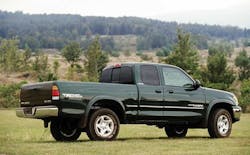Across the Tundra
SUBJECT VEHICLE: 2007-09 Toyota Tundra.
SENSOR IN TIRE? Yes.
RESET PROCEDURE? Yes.
SPECIAL TOOLS NEEDED? Yes (Techstream tool).
The Toyota Tundra’s tire pressure monitoring system (TPMS) contains a valve sub-assembly that consists of a tire pressure sensor and a transmitter, both of which are installed in each tire and wheel assembly.
The sensor sends tire pressure data to the tire pressure receiver assembly as radio waves. These waves are then sent to the tire pressure ECU from the tire pressure monitor receiver.
If the transmitter ID has been registered, the ECU compares the measured air pressure value with the standard value. When the value is less than the standard value registered in the ECU, the warning light on the instrument cluster turns on.
To address the differences in the air pressure settings by tire type, a tire pressure warning reset switch is used. This switch initializes the warning system after certain repair procedures.
Sensor removal
To remove an old sensor and install a new one, follow these steps:
1. Remove the wheel and remove the valve core and cap. Release the air from the tire.
2. Remove the nut and the washer that is used to hold the sub-assembly and then drop the sensor into the tire.
3. Disengage the bead using the shoe of the tire remover.
4. Remove the bead on the upper side.
5. Take out the sensor. Remove the bead on the lower side.
6. Remove the inner grommet from the tire pressure monitor valve sub-assembly.
Now you’re ready to install the new sensor.
1. Insert the tire pressure monitor valve into the valve installation hole. Insert it from the inside of the rim so the print surface can be seen.
2. Install the washer on the tire pressure monitor valve from the rim side. Tighten the nut to 35 in.-lbs.
3. Set the wheel disc to the mounting machine. Install the lower tire bead.
4. Making sure that the tire bead and tool do not interfere with the main body of the sensor, install the upper bead.
5. Inflate the tire. Retighten the valve nut to the specified torque. Check for air leaks with soapy water.
6. Install the tire and wheel assembly.
Now it’s time for initialization.
[PAGEBREAK]
How to initialize
The TPMS will need to be initialized whenever tires are rotated; tires are replaced with tires of different pressures; the sensor has been replaced; or when a new vehicle is delivered.
Before initializing, set the tire pressure within the specified range. Then follow these steps:
1. Turn the ignition switch ON.
2. Press and hold the tire pressure warning reset switch for three seconds or more so that the tire pressure warning light blinks three times.
3. Turn the ignition switch OFF.
4. Connect the Techstream to the DLC3. Turn the ignition switch ON and the Techstream ON. It may take five or six minutes for the “TIREPRESS” command to display on the screen.
5. Enter the following menus: Chassis/Tire Pressure Monitor/Data List.
6. Confirm that the tire pressure data on all three tires are displayed on the Techstream screen.
Now it’s time to register the transmitter ID. Here’s how:
1. Set the tire pressure in all four tires to the specified values.
2. Turn the ignition OFF.
3. Connect the Techstream to the DLC3.
4. Turn the ignition ON. Turn the Techstream on.
5. Enter the following menus: Chassis/Tire Pressure Monitor/Data List.
5. Enter the following menus: Chassis/Tire Pressure Monitor/Data List.
It may take five to six minutes to update the tire pressure data. Also when servicing the Tundra’s TPMS, keep in mind that the system may not function properly under the following conditions: a radio device of similar frequency is being used near the vehicle; a lot of snow and/or ice is stuck on the vehicle, especially in the wheel wells; the sensor battery has been depleted; a tire without the tire pressure monitor valve sub-assembly has been used; if other wheels other then officially specified rims are in use; and if tire chains are being used. ■
Information for this column comes from Mitchell 1’s ”Tire Pressure Monitoring Systems Guide” for domestic and import vehicles through 2008. Headquartered in Poway, Calif., Mitchell 1 has provided quality repair information solutions to the automotive industry for more than 80 years. For more information, visit www.mitchell1.com.
